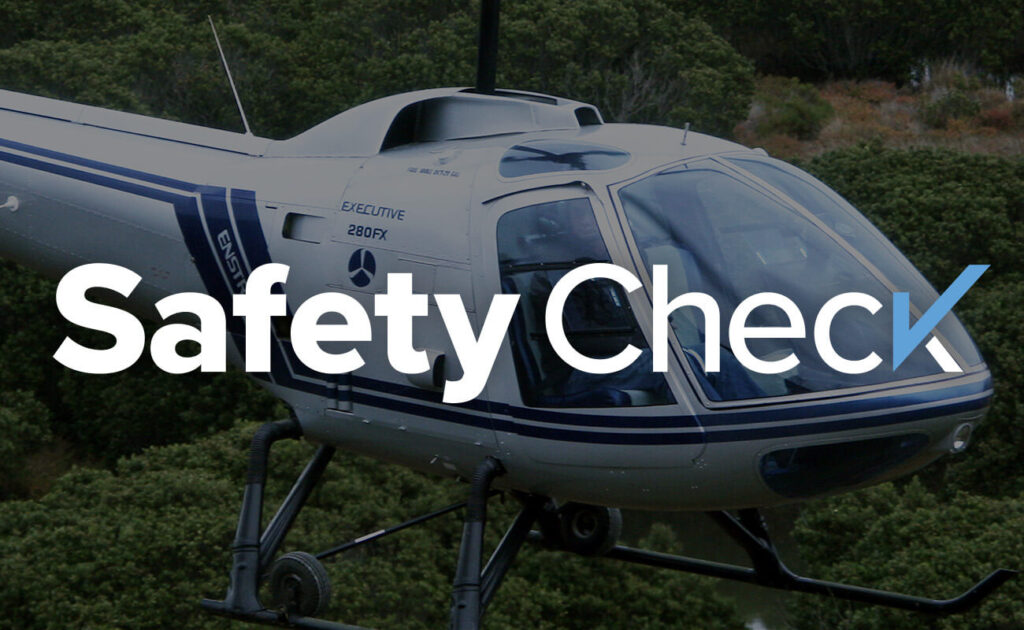Safety Check: Behind the Scenes of Enstrom’s D.C. Flyover

It’s summer flying season, and helicopter pilots are frequently called upon to fly for airshows or other aviation events.
That might involve giving rides, doing flyovers, demonstrating our aircraft, or just parking our helicopters for static displays. Not only are these a great way to show people the amazing inner workings of helicopters, but they can also be a lot of fun! However, as always, when we are participating in these events, we need to make sure we are doing it safely.
Recently, Enstrom was able to participate in a really unique event. AOPA, the Aircraft Owners and Pilots Association, was celebrating its 85th anniversary and had arranged a flyover of downtown Washington, DC. Only 60 aircraft were invited, and of those, only 3 were helicopters, so it was quite an honor! You can find out more information here.
For this Safety Check, I want to share a behind-the-scenes look at the months of preparation it took for us to pull this off.
AOPA held its first two-hour online briefing way back in January and then packed in three more briefings by the time we finally pulled pitch. In the meantime, my passengers and I had to get Secret Service Clearances, the FAA ramped check our aircraft, and the morning of the flight, they even swept all the aircraft for bombs!
To make the flyover manageable, AOPA broke it up into 22 different flights. Each flight needed to take off at a designated time, fly a specific route, and maintain a specified airspeed. Some of the flights flew as slow as 80 kts, while others flew as fast as 165 kts, but if everyone played their part, each flight would reach the National Mall approximately one minute apart.
I found myself flying in between VAI President Jim Viola in his R44 and Matt Desch in his EC120. Taking off from AOPA’s home airport in Frederick, MD (KFDK), we flew almost directly south, climbed to 2000 feet to pick up the Potomac Approach, and then dropped to 1000 feet once we intercepted the Potomac River. We followed the river through all its twists and turns until we reached downtown Washington, D.C.
We turned left, keeping south of the Lincoln Memorial, and flew right down Independence Avenue. The FAA made it clear; under NO circumstances were we to drift north of here toward the White House or east toward the Capitol. I didn’t ask what would happen, and to be honest, I don’t want to know.
The Hirshhorn Museum marked our next turn, sending us south toward the Potomac and right past the Ronald Reagan Washington National Airport. AOPA had arranged to shut the airport down for an hour to clear the skies for our flyover, which in and of itself was an impressive feat.
From there, we passed Mt. Vernon and traveled west around the Class B back up to KFDK. The result was a flawless flight on one of the biggest stages most pilots will ever see.
While not every event requires months of prep and hours of briefings, the basic elements should be the same. If you are ever asked to participate in an air show or flyover, make sure the organizers have crossed their t’s and dotted their i’s. With a solid plan in place, solid communication becomes key. Pay attention in your briefings and execute your part. Don’t try to go off-script.
If something doesn’t feel right, stop! You won’t be seen as a spoilsport. During last year’s Rotors ‘n Ribs, we attempted to set a Guinness World Record for most helicopters in a hover state at one time. The organizers had a good plan, we briefed on it, but one of our pilots still didn’t feel comfortable participating. No one was upset. He made the right call for him, and the show moved on.
Have fun showing off your helicopter this summer. Just remember, the goal here is safety. Not just for you, but for your passengers and the people attending the event, and nothing is less fun than an accident. So fly safe!
Dennis Martin is the Chief Commercial Officer for Enstrom Helicopter Corporation. He has been with Enstrom for more than 14 years, working in both sales and engineering, and has traveled to over 25 different countries. Dennis is a commercial-rated rotary and fixed-wing pilot, as well as an A&P/IA.
About Enstrom Helicopter
From Rudy Enstrom’s early designs in 1943 to initial testing in a Michigan Quarry in 1957 to aircraft operating on six continents, Enstrom Helicopter Corporation has maintained a reputation for safety, value and performance. Based in Menominee, Michigan and proudly made in the United States, Enstrom has a rich history for design innovation. The goal is to provide helicopters to the customer’s exact specification and deliver support and maintenance worldwide.